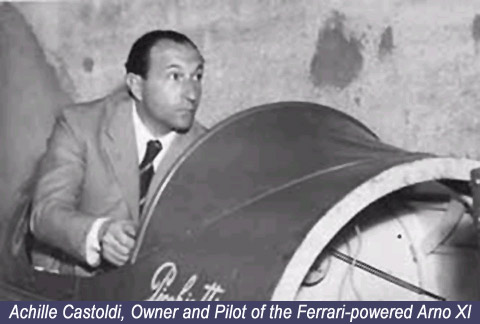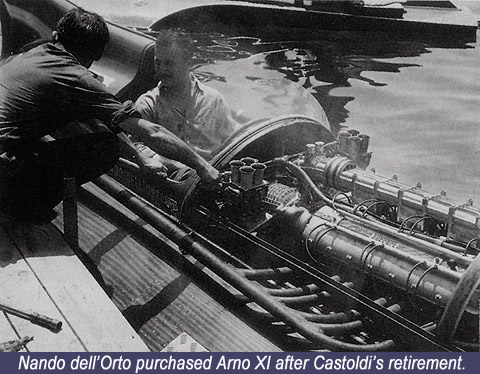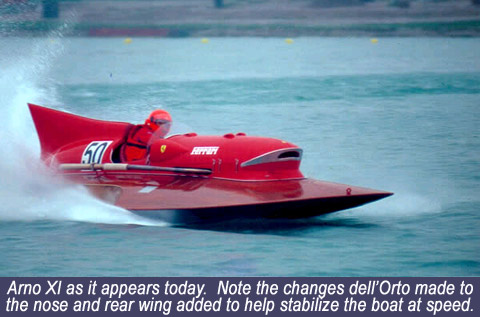|
 "For
1953, Castoldi commissioned an 800kg-class three-point hydroplane
hull to be built by Cantieri Timossi, and for the engine, he
turned to the new up and comers of the auto racing scene –
Scuderia Ferrari." "For
1953, Castoldi commissioned an 800kg-class three-point hydroplane
hull to be built by Cantieri Timossi, and for the engine, he
turned to the new up and comers of the auto racing scene –
Scuderia Ferrari."
If you’re
like me, you get that… sinking feeling with every repost on
FerrariChat of the wooden F50 or the “Faux-Rarri” style ski boats
with garish vinyl “Ferrari” decals. Allow me to provide some
nautical relief: Here's the first installment of a two-part piece
covering a pair of hydroplane racing boats with real claims to the
Ferrari name.
 BACKGROUND BACKGROUND
In the 1930s and 1940s, loud, fast racecars were entertaining the
masses, allowing automobile manufacturers to show their
engineering prowess and providing a way for wealthy sportsmen to
get their kicks. But automobile racing wasn’t the only show in
town. Championship speed boat competition, in the form of nautical
circuit racing, endurance racing and flat-out top speed record
chasing were popular the world over.
Just as auto manufacturers were developing engines and race cars
in cooperation with thrill-seeking rich guys, those same racing
motors made attractive power plants for builders of competition
boats. As we all know, publicity and advertising foot the bill for
competition. In Italy, auto manufacturers such as Alfa Romeo and
Maserati took pride in teaming up with Italian boat racers by
supplying them with retired racecar power plants.
 Achille
Castoldi was one such wealthy boat privateer. In 1940, Castoldi
set the world speed record of 81.10mph in the 400kg class with his
boat Arno, a Picciotti hull powered by an Alfa Romeo type 158
engine. Castoldi subsequently built a number of Arnos, mostly with
Alfa engines, but at least one was powered by a Maserati racing
mill. In 1952, Castoldi severed his ties with Alfa Romeo, or maybe
Alfa severed their ties with Castoldi? It’s not clear one way or
the other. Achille
Castoldi was one such wealthy boat privateer. In 1940, Castoldi
set the world speed record of 81.10mph in the 400kg class with his
boat Arno, a Picciotti hull powered by an Alfa Romeo type 158
engine. Castoldi subsequently built a number of Arnos, mostly with
Alfa engines, but at least one was powered by a Maserati racing
mill. In 1952, Castoldi severed his ties with Alfa Romeo, or maybe
Alfa severed their ties with Castoldi? It’s not clear one way or
the other.
TIMOSSI FERRARI ARNO
XI
For 1953, Castoldi decided to focus less on circuit racing, and to
concentrate on setting top speed records. He commissioned an
800kg-class three-point hydroplane hull to be built by Cantieri
Timossi, a hydroplane builder on Lake Como, near Milan. The
hydroplane was constructed with a solid wood frame skeleton with a
marine plywood skin and a mahogany veneer. The aluminum fairing,
rear aerodynamic stabilizer and engine cover were painted in red,
the traditional color of Italian racers. The hull was dubbed Arno
XI. For the engine, he turned to the new up and comers of the auto
racing scene – Scuderia Ferrari.
 Ferrari supplied Castoldi with a type 375 V-12 Grand Prix engine,
the same type that powered Ferrari’s racecars in ’51 and ‘52. The
supplied engine displaced 4493.7cc, each cylinder with an 80mm
bore & 74.5mm stroke. There were two spark plugs per cylinder, a
12:1 compression ratio and the stock engine made approximately
385bhp. Ignition was handled by magnetos, rather than a
distributor and coil. Ferrari supplied Castoldi with a type 375 V-12 Grand Prix engine,
the same type that powered Ferrari’s racecars in ’51 and ‘52. The
supplied engine displaced 4493.7cc, each cylinder with an 80mm
bore & 74.5mm stroke. There were two spark plugs per cylinder, a
12:1 compression ratio and the stock engine made approximately
385bhp. Ignition was handled by magnetos, rather than a
distributor and coil.
The engine was mated to a gear step-down box which spun the twin
bladed propeller at up to 10,000 rpm. The propeller shaft ran at a
shallow downward angle toward the rear of the hydroplane (the
angle got steeper, of course, as the aerodynamics of the
three-point hull lifted the bow of the boat at speed). The
propeller shaft and the engine both were kept cool by the fresh
water of the European lakes where the boat raced.
RECORD SETTER
At the January 1953 Campione d’Italia races, Castoldi piloted Arno
XI to an unofficial top speed in excess of 124mph during the
shakedown testing, prior to the official two-way run. His rival,
Mario Verga, had taken Castoldi’s place at Alfa Romeo, who were
lending their full official support to Verga, including their
technical staff and press officer. Verga managed to set the
800kg-class speed record of 125.68mph with his Alfa 159 powered
Laura. Two weeks later, he surpassed his own record
with a two-way top speed of 140.74mph.
 In
preparation for another attempt at breaking Verga’s new record,
Castoldi had a new engine built with twin superchargers, which
compressed the air and fuel delivered by a pair of massive 4
barrel Weber carburetors. The engine was tuned to burn methanol,
which allowed the compression ratios to be increased and the
superchargers to produce plenty of boost with less risk of
detonation. Arno XI’s new methanol burning, twin supercharged 4.5L
Ferrari power plant produced between 550 and 600 brake horse
power. In
preparation for another attempt at breaking Verga’s new record,
Castoldi had a new engine built with twin superchargers, which
compressed the air and fuel delivered by a pair of massive 4
barrel Weber carburetors. The engine was tuned to burn methanol,
which allowed the compression ratios to be increased and the
superchargers to produce plenty of boost with less risk of
detonation. Arno XI’s new methanol burning, twin supercharged 4.5L
Ferrari power plant produced between 550 and 600 brake horse
power.
Enzo Ferrari sent Stefano Meazza, the chief race engineer of the
Scuderia, to help prepare the new supercharged engine. Grand Prix
champion Alberto Ascari and driver Luigi Villoresi showed the
support from the Scuderia by attending the event. On the morning
of October 15, 1953, Achille Castoldi succeeded in smashing the
800kg class speed record with an average “flying kilometer”
two-way speed of 150.49 mph. Ascari and Villoresi boarded a small
boat and pulled up alongside Arno XI to congratulate their friend
Castoldi. He followed up the performance later that day by setting
another record in the “24 nautical miles” event with an average
speed of 102.34 mph.

Castoldi
retired from hydroplane racing in 1954, after a scary and violent
engine failure while traveling at high speeds in a new
airplane-engined 1700kg Timossi hydroplane. His rival, Mario Verga,
died in a separate hydroplane accident a short time later.
Achille Castoldi sold Arno XI to a wealthy engineer named Nando
dell’Orto. Ingnere dell’Orto revised the body lines of the engine
cover and front fairing, added a large fin behind the driver for
stability, and raced the boat for a few more years. The most
notable success was a 2nd place finish in the 1965 900kg World
Championship.

Arno XI was
restored in the early 1990s and was put up for auction at the
Coy’s Festival at Silverstone in 1997 where it did not sell. It
was photographed skimming across the water as recently as
September 2004, along with many other vintage racing boats.
In part
two, I'll discuss adventurer Guido Monzino and his hydroplane
powered by a Ferrari 375 Mille Miglia engine that once competed at
both Le Mans and the Carrera Panamericana.
The following people, publications, and
websites were indispensable in the research and writing of this
article:
Books:
Classic Speedboats 1945-1962: The Summit, by Gerald G. Guetat.
Motorbooks International Osceo, WI 2000
Ferrari, by Hans Tanner. 4th ed. GT Foulis & Co LTD, London 1974
Magazines:
Ferrari World, Jan/Feb 1992, Issue 16
Websites:
www.vintagehydroplanes.com
www.barchetta.cc
www.asdec.it
www.scaleautoworks.com
www.leggendaepassione.it
www.barchedacorsastoriche.com
www.historicracingboats.com
People:
Cyril Teste (Aardy) @ FerrariChat.com
Bill (Glassman) @ FerrariChat.com
Ron (ronzalfa) @ FerrariChat.com
Rob Kaufman @ vintagehydroplanes.xom
Bob Foley @ vintagehydroplanes.com
|

